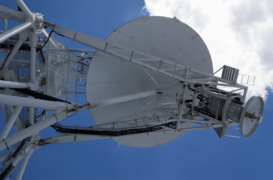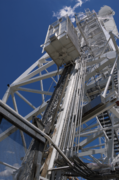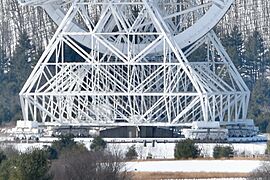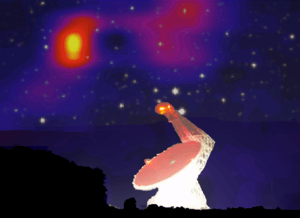Green Bank Telescope facts for kids

The Green Bank Telescope
|
|
| Alternative names | GBT |
|---|---|
| Named after | Robert Byrd |
| Part of | Green Bank Observatory |
| Location(s) | Green Bank, United States National Radio Quiet Zone, Pocahontas County, United States |
| Coordinates | 38°25′59″N 79°50′23″W / 38.4331211°N 79.839835°W |
| Organization | Green Bank Observatory National Radio Astronomy Observatory |
| Observing time | 365 nights per year |
| Built | 1990–2000 |
| First light | 23 August 2000 |
| Telescope style | radio telescope |
| Diameter | 100 m (328 ft 1 in) |
| Collecting area | 2.34 acres (102,000 sq ft) |
| Focal length | 60 m (196 ft 10 in) |
| Website | greenbankobservatory |
| |
|
The Robert C. Byrd Green Bank Telescope (GBT) is the biggest fully steerable radio telescope in the world. It is located in Green Bank, West Virginia, in the United States. This amazing telescope helps scientists study the universe by listening to radio waves from space.
The GBT is named after Robert C. Byrd, a senator from West Virginia. He helped get the money needed to build this huge telescope. It started working in 2001. Before the GBT, another telescope at the same site, called the 300 Foot Radio Telescope, collapsed in 1988.
The GBT can "see" radio waves from very long to very short wavelengths. Its main dish is 100 meters (about 328 feet) wide. This large size and special design help it collect faint signals from far away in space. The telescope can move to point at 85% of the sky. It works for astronomy about 6,500 hours each year.
Scientists use the GBT for many different projects. It is easy to change and update with new equipment. This flexibility allows researchers to quickly explore new ideas. The GBT works with other powerful telescopes, like the Atacama Large Millimeter Array, to get a full picture of space. The Green Bank Observatory also teaches students and the public about science.
Contents
Where is the Green Bank Telescope Located?
The GBT is in a special place called the United States National Radio Quiet Zone. This zone is in Green Bank, West Virginia. In this area, people limit radio signals from things like cell phones and Wi-Fi. This helps the telescope pick up very weak radio signals from space without interference from human-made noise.
The observatory is also surrounded by National Forest land. The Allegheny Mountains help block out even more radio interference. This quiet location is perfect for listening to the universe. The site has been home to important radio telescopes since 1957. Many people visit the observatory each year to learn about space.
How the Green Bank Telescope Works
The GBT is a giant machine, weighing about 7,600 metric tons (over 16 million pounds). It stands 148 meters (485 feet) tall, which is much taller than the Statue of Liberty. Because of its huge size, some local people call it the "Great Big Thing."
The telescope's dish is 100 by 110 meters (328 by 360 feet) across. It has a special "active surface" made of 2,004 panels. Underneath these panels are 2,209 small motors called actuators. These motors constantly adjust the panels. This keeps the dish perfectly shaped, even as it moves and gravity pulls on it. This active surface helps the GBT make clear observations at high frequencies.
Unlike most radio telescopes, the GBT's main dish is not perfectly round. It's an "off-axis" design. This means the part that collects the radio waves (the feed horn) is located to the side of the dish. This design prevents the feed horn from blocking the incoming radio waves, which makes the telescope more efficient.
A long arm, about 60 meters (200 feet) long, holds the receivers. These receivers are like ears that listen to the radio waves. The telescope can tilt up and down from 5 to 95 degrees. It can also spin all the way around. Large motors and gears help it move smoothly and precisely.
The GBT can even be used like a radar! It has a system called ngRADAR. This system uses the dish to send out radar signals. It then listens for the echoes from objects in our Solar System, like asteroids. This helps scientists create images of these objects.
- Green Bank Telescope components
-
Actuators (black) under the surface panels for surface fine-tuning
Amazing Discoveries by the GBT
The GBT has helped scientists make many exciting discoveries about space.
- In 2002, astronomers found three new pulsars in a group of stars called Messier 62. Pulsars are like cosmic lighthouses that spin very fast.
- In 2006, scientists found a huge, coil-shaped magnetic field in the Orion molecular cloud. They also discovered a giant bubble of hydrogen gas, 23,000 light years away, called the Ophiuchus Superbubble.
- In 2019, the GBT helped find the most massive neutron star ever seen, named PSR J0740+6620. Neutron stars are incredibly dense, collapsed stars.
- Since 2004, the GBT has helped discover 28 new complex molecules in the space between stars. These molecules are important building blocks for planets and life.
Keeping the Telescope Running
In 2012, there were concerns about money for the GBT. The National Science Foundation (NSF), which helped fund the telescope, looked at closing some facilities. However, the United States Senate Committee on Appropriations decided to continue funding the GBT.
To make sure the telescope could keep working, the Green Bank Observatory became an independent organization on October 1, 2016. It now gets money from different sources, including private groups, to cover its operating costs. This means the GBT can continue its important work exploring the universe.
Searching for Alien Life
The GBT is a very important part of the Breakthrough Listen project. This project uses powerful telescopes to search for radio signals from possible alien technologies. It's like listening for a message from another civilization in space.
In late 2017, the GBT was used to scan a mysterious object from outside our Solar System called ʻOumuamua. Scientists listened for any signs of extraterrestrial intelligence as it flew past Earth.
See also
 In Spanish: Telescopio de Green Bank para niños
In Spanish: Telescopio de Green Bank para niños
- Grote Reber
- List of astronomical observatories
- List of radio telescopes
- Project Ozma
External links
- Green Bank Observatory GBT page
de:Green-Bank-Observatorium














